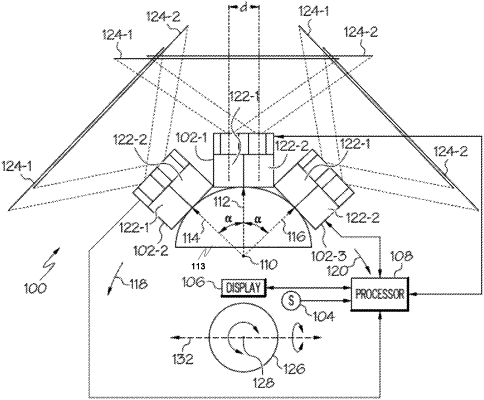| CPC H04N 23/698 (2023.01) [H04N 23/632 (2023.01)] | 20 Claims |

|
1. A panoramic image system with parallax mitigation, the system comprising:
a plurality of image sensors for providing image data, the plurality of image sensors comprising:
a first image sensor that provides an image with a first field of view (FOV) and a second image sensor that provides an image with a second FOV;
wherein the first FOV has a non-overlapping section that does not overlap with the second FOV and an overlapping section that overlaps with the second FOV;
wherein the second FOV has a non-overlapping section that does not overlap with the first FOV and an overlapping section that overlaps with the overlapping section of the first FOV; and
wherein the overlapping section of the first FOV overlaps with the overlapping section of the second FOV and the overlapping section of the second FOV overlaps with the overlapping section of the first FOV;
a head tracker configured to supply an azimuth position signal and an elevation position signal representative of an angular position of a viewer's head, wherein the azimuth position signal corresponds to an azimuth angle and the elevation position signal corresponds to an elevation angle;
a display configured to selectively display images sensed by the image sensors in an instantaneous FOV (IFOV); and
a controller in operable communication with the plurality of image sensors, with the head tracker, and with the display, the controller configured to:
generate the IFOV from the image data from the plurality of image sensors, wherein the image sensors that contribute image data to the IFOV are determined based on the azimuth angle and the elevation angle;
wherein, when the IFOV includes image data from both the first image sensor and the second image sensor which have overlapping FOVs, the IFOV includes a portion of the non-overlapping section of the first FOV, the overlapping sections of both the first FOV and the second FOV, and a portion of the non-overlapping section of the second FOV;
wherein the overlapping section of the first FOV is blended with the overlapping section of the second FOV to form a blended overlapping section, wherein each of the overlapping section of the first FOV and the overlapping section of the second FOV has a level of contribution to the blended overlapping section;
wherein the level of contribution to the blending from the overlapping section of the first FOV increases as the viewer's head moves in a first angular direction and decreases as the viewer's head moves in a second angular direction;
wherein the level of contribution to the blending from the overlapping section of the second FOV decreases as the viewer's head moves in the first angular direction and increases as the viewer's head moves in the second angular direction; and
wherein the first and second angular directions both correspond to a change in azimuth or both correspond to a change in elevation.
|